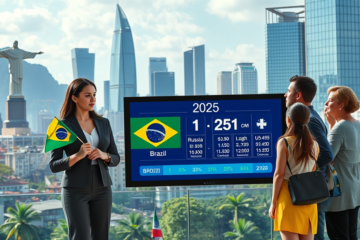Economic Growth and GDP Measurement
Economic Growth is a central theme in discussions about the future of Brazil, especially in light of the perspectives of renowned economists such as Philippe Aghion.
In this article, we will explore whether Brazil truly experiences low economic growth or whether there are flaws in the ways this growth is measured.
By analyzing Gross Domestic Product (GDP) and the changes brought about by technological innovation, we will highlight how improvements in quality and cost reductions may not be reflected in current statistics, making it necessary to reevaluate our understanding of the country's economic progress.
Philippe Aghion and the Debate on Brazilian Growth
In the article 'Call Nery', Philippe Aghion's ideas on the economic growth of Brazil and how possibly an inadequate measurement can underestimate its true progress.
Despite technological innovations that revolutionize entire sectors, as illustrated by evolution of photography, these changes are often not adequately captured by traditional GDP statistics.
Aghion points out that innovations directly impact quality of life by reducing costs and increasing efficiency, but these benefits are often invisible to GDP.
This perception raises questions about whether Brazil is really growing little or whether we are simply measuring things wrong.
As a result, there may be an underestimation of GDP of about 0.6% per year.
Aghion's reflection invites a deeper examination of how we account for innovations that reduce waiting times and make daily experiences more fluid and accessible, showing that the technique of measuring progress can be as crucial as the progress itself.
Reevaluate growth metrics could redefine how we interpret Brazil's economic development, promoting a more holistic understanding of the country's real progress.
Limitations of GDP in Capturing Innovations
Gross Domestic Product (GDP) is often used as a measure of economic growth, but it has significant limitations in capturing innovations.
According to Nobel Prize winner in Economics Philippe Aghion, this metric ignores qualified advances and price reductions that result from technological innovations, which can lead to an underestimation of real growth.
By not adequately reflecting the benefits brought by innovation, GDP can distort the true evolution of a country's quality of life and economic efficiency.
Photography: Metaphor for Invisible Progress
The digital transformation of photography represents a clear example of how innovation may not be fully captured in traditional economic growth metrics.
With the evolution of the photographic process, there was a significant reduction in costs and time necessary to obtain images.
Previously, taking photos on physical media involved spending money on rolls of film, developing and printing.
Now, with the advent of digital cameras and smartphones, we can capture thousands of images instantly and share them at no additional cost.
However, these advances are not adequately reflected in the Gross Domestic Product.
GDP, focused on market transactions, fails to account for efficiency and quality improvements that do not directly imply measurable economic transactions.
Thus, the quality of life that has increased through cost reduction and waiting in the photographic process it ends up getting lost in formal statistics.
This discrepancy highlights the need to reformulate our economic indicators, embracing the idea of a measurement that considers the value of invisible technological progress.
For more information about photography in Brazil, visit Panorama of the Photography Market.
Annual Underestimation of 0.6 % of GDP and Quality of Life Gains
Recent discussions about Brazil's economic growth raise the hypothesis that GDP may be underestimated by 0.6 % per year.
This view, inspired by the ideas of Nobel Prize winner Philippe Aghion, suggests that Gross Domestic Product (GDP) does not adequately reflect technological advances, which provide cost reductions and improve quality of life without appearing in official statistics.
For example, consider the evolution of digital photography, which has dramatically reduced the time and cost of capturing and sharing images, illustrating how innovation makes everyday life easier.
Similarly, advances in delivery services and automation in industrial processes are concrete examples of efficiency gains.
The direct impact of this on the citizen is an improvement in quality of life..
Shorter wait times and greater service efficiency result in conveniences that current GDP does not measure.
This raises questions about how we measure our economic progress.
See the table below which illustrates the possible underestimation:
| Year | Adjustment (%) |
|---|---|
| 2023 | 0,6 |
These technological advances, often ignored in traditional GDP measurements, raise the standard of living of Brazilians, resulting in greater satisfaction and comfort in their daily lives.
More information on this context can be found at Estadão.
Understanding this discrepancy allows for a more accurate and optimistic view of Brazil's economic progress.
In summary, this article reinforces the importance of reviewing economic growth metrics, recognizing that technological innovations and their implications for quality of life may be underestimated in current analyses, which challenges the conventional view of Brazil's growth.



0 Comments